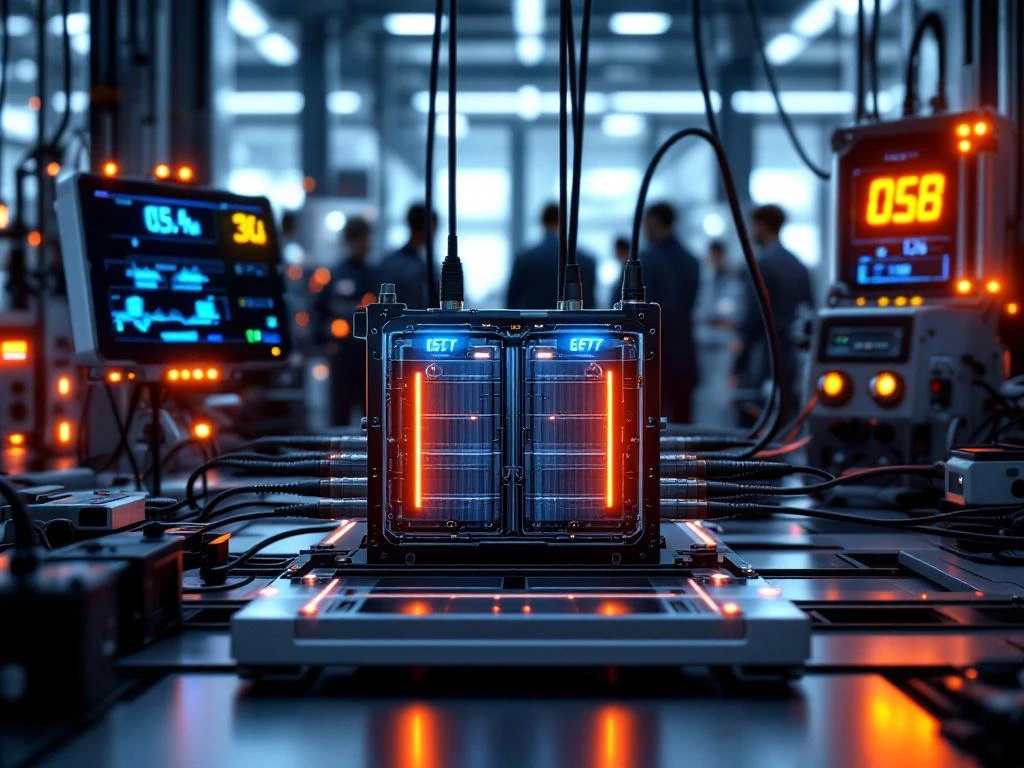In the high-stakes world of Formula racing and performance motorsports, battery system failures aren’t just inconvenient—they can be catastrophic. Whether you’re running a Formula racing team or retrofitting sports cars with cutting-edge energy storage solutions, your battery safety inspections determine the difference between victory and disaster. Modern modular battery inspection protocols have evolved far beyond simple voltage checks, encompassing comprehensive safety protocols that protect both equipment and personnel.
The racing environment presents unique challenges for energy storage safety, with extreme temperatures, vibrations, and electrical demands that push battery systems to their absolute limits. A systematic approach to battery system maintenance ensures your power source performs when it matters most, whilst maintaining the safety standards that keep your team competitive and protected.
1. Why regular safety inspections are critical for battery systems
Regular industrial battery safety inspections form the backbone of any reliable energy storage system, particularly in high-performance applications where failure isn’t an option. These systematic evaluations prevent catastrophic failures that could result in fires, explosions, or complete system shutdowns during critical moments on the track.
Beyond immediate safety concerns, consistent inspection schedules maximise battery system lifespan by identifying degradation patterns before they become serious problems. This proactive approach proves especially valuable in racing applications, where battery replacement costs and downtime can significantly impact team budgets and competitive schedules.
Regulatory compliance adds another layer of importance to these inspections. Racing organisations increasingly require documented safety protocols for energy storage systems, making thorough inspection records essential for maintaining competition eligibility and insurance coverage.
2. Thermal management system verification
Thermal management inspection represents one of the most critical aspects of battery pack testing, as overheating remains the primary cause of battery system failures in high-performance applications. Your cooling systems, temperature sensors, and thermal barriers must function flawlessly under the extreme conditions typical of racing environments.
During verification, examine all cooling system components including pumps, radiators, and coolant lines for signs of wear, blockages, or leaks. Temperature sensors require calibration checks to ensure accurate readings, whilst thermal barriers need inspection for physical damage that could compromise their protective capabilities.
Heat dissipation components deserve particular attention, as inadequate thermal management can trigger cascading failures throughout the entire battery pack. Regular thermal imaging during operation helps identify hot spots that might not be apparent during static inspections.
3. Electrical connection integrity assessment
Comprehensive electrical safety checks focus on every connection point within your battery system, from high-voltage terminals to communication cables. Corrosion, loosening, or degradation at any junction point can lead to system failures, arcing, or dangerous fault conditions during operation.
Visual inspection should cover all terminals, cables, and junction points, looking for discolouration, corrosion, or physical damage. Torque specifications for all connections must be verified, as vibrations in racing applications can gradually loosen even properly installed hardware.
Resistance measurements across connections help identify degraded joints before they fail completely. This testing proves particularly important for high-current connections where even small increases in resistance can generate dangerous heat levels during operation.
4. Battery management system functionality check
Your battery monitoring systems serve as the central nervous system for the entire energy storage setup, making their proper function absolutely critical for safe operation. BMS components including voltage monitoring, current sensing, and cell balancing functions require regular validation to ensure accurate system control.
Testing protocols should verify that voltage monitoring circuits accurately measure individual cell voltages across the entire pack. Current sensing accuracy becomes particularly important in racing applications where precise power management can affect performance outcomes.
Communication protocols between the BMS and other vehicle systems need verification to ensure proper data transmission and command execution. Cell balancing functions require testing under various charge states to confirm they maintain pack uniformity effectively.
5. Physical housing and enclosure inspection
The structural integrity of your battery pack housing provides the first line of defence against environmental hazards and mechanical damage. Racing applications subject these enclosures to extreme vibrations, impacts, and temperature cycling that can compromise their protective capabilities over time.
Examine all housing components for cracks, deformation, or signs of stress concentration that could lead to failure. Pay particular attention to mounting points, as these areas experience the highest mechanical loads during vehicle operation.
Seals and gaskets require careful inspection to ensure continued environmental protection. Even small seal failures can allow moisture ingress that leads to corrosion or electrical faults within the battery pack.
6. Cell voltage and capacity measurement
Individual cell testing procedures provide crucial insights into battery pack health and help identify cells showing signs of degradation before they affect overall system performance. Modular battery inspection techniques allow for detailed analysis of each cell’s contribution to pack performance.
Voltage measurements should be taken at various states of charge to identify cells with unusual voltage characteristics. Capacity testing reveals cells that no longer hold their rated energy, which can create imbalances that stress the entire pack.
Internal resistance measurements help identify cells with increased impedance that may limit power delivery capability. This testing proves particularly valuable in racing applications where maximum power output is essential for competitive performance.
7. Safety system and emergency shutdown testing
Emergency disconnect systems and safety interlocks must function reliably when called upon, making their regular testing non-negotiable for safe operation. These systems represent your last line of defence against catastrophic failures and must respond correctly under all operating conditions.
Test all emergency disconnect mechanisms to ensure they completely isolate the battery pack from vehicle systems within specified time limits. Safety interlocks should prevent system operation when unsafe conditions are detected, such as open enclosures or cooling system failures.
Automated shutdown procedures require validation under simulated fault conditions to verify proper system response. This testing should include scenarios specific to racing applications, such as impact detection or extreme temperature conditions.
8. Insulation resistance and ground fault detection
Electrical isolation between high-voltage components and chassis ground provides essential protection against electric shock and system faults. Regular insulation resistance testing ensures this protection remains effective throughout the battery system’s operational life.
Measure insulation resistance between all high-voltage circuits and ground using appropriate test equipment. Values below specified thresholds indicate deteriorating insulation that could lead to dangerous fault conditions.
Ground fault detection systems require testing to ensure they respond correctly to simulated fault conditions. These systems must distinguish between normal leakage currents and actual fault conditions whilst providing reliable protection.
9. Ventilation and gas detection system review
Proper ventilation prevents dangerous gas accumulation that could lead to explosive conditions, particularly important in enclosed racing environments where natural air circulation may be limited. Gas detection systems provide early warning of potentially hazardous conditions.
Verify that ventilation fans operate at specified flow rates and that air circulation patterns effectively remove gases from all areas of the battery enclosure. Blocked vents or failed fans can quickly create dangerous conditions during operation.
Gas sensors require calibration verification using known gas concentrations to ensure accurate detection capabilities. These sensors must respond quickly enough to provide useful warning before dangerous concentrations develop.
10. What should you check in fire suppression systems?
Fire detection and suppression systems specifically designed for battery applications require specialised inspection procedures due to the unique characteristics of battery fires. These systems must detect fires quickly and deploy appropriate suppression agents effectively.
Fire detection sensors need testing with appropriate stimuli to verify rapid response times. Battery fires can develop and spread quickly, making early detection absolutely critical for effective suppression.
Suppression agent levels and discharge mechanisms require regular verification to ensure adequate protection coverage. The suppression system must be capable of cooling the battery pack sufficiently to prevent thermal runaway propagation.
11. Communication and monitoring network validation
Data communication links enable real-time monitoring and control of battery systems, making their reliable operation essential for safe system management. Remote monitoring capabilities allow teams to track system performance and identify developing problems before they become critical.
Test all communication protocols to ensure reliable data transmission between battery systems and monitoring equipment. Signal integrity becomes particularly important in racing environments with high levels of electromagnetic interference.
Alarm systems must function correctly to alert operators of fault conditions or safety concerns. These systems should provide clear, actionable information that enables appropriate response to developing problems.
12. Environmental condition monitoring assessment
Environmental sensors protect battery systems against harsh operating conditions that could affect performance or safety. Racing environments expose batteries to extreme temperatures, humidity variations, and potential contamination that can compromise system operation.
Humidity controls and contamination detection systems require regular calibration to maintain accuracy. These systems must respond appropriately to changing environmental conditions whilst avoiding false alarms that could disrupt operations.
Protective measures against environmental hazards need verification to ensure continued effectiveness. This includes checking seals, filters, and other barriers that prevent harmful environmental factors from affecting battery performance.
Implementing a comprehensive battery safety inspection program
Establishing a systematic approach to battery safety inspections transforms these individual checks into a powerful tool for maintaining peak system performance and safety. The key lies in creating regular inspection schedules that align with your operational demands whilst ensuring nothing falls through the cracks.
Training requirements for inspection personnel cannot be overlooked, as proper technique and attention to detail make the difference between effective inspections and mere box-ticking exercises. Documentation procedures should create clear records that track system health over time and support regulatory compliance requirements.
Integration with your overall maintenance strategy ensures that battery inspections complement other system maintenance activities, maximising efficiency whilst maintaining comprehensive coverage. When inspections reveal potential issues or safety concerns, having proper emergency response protocols in place becomes essential for maintaining safe operations. The investment in systematic inspection procedures pays dividends through improved reliability, extended system life, and enhanced safety for your entire operation. When you’re ready to develop a customised inspection program tailored to your specific racing applications, don’t hesitate to contact our team for expert guidance.



